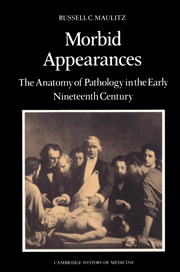Book contents
- Frontmatter
- Contents
- Dedication
- Preface
- Introduction: Ouverture: Bichat's head
- PART ONE PARIS
- 1 Genesis of a tradition
- 2 Pathology and the Paris faculty
- 3 Pathology in the middle
- 4 The center holds
- PART TWO CHANNEL CROSSING
- PART THREE LONDON
- Conclusion: A language of morbid appearances
- Appendix: Transcription and translation of Figure 1.1
- Notes
- Selected bibliography
- Index
3 - Pathology in the middle
Published online by Cambridge University Press: 22 September 2009
- Frontmatter
- Contents
- Dedication
- Preface
- Introduction: Ouverture: Bichat's head
- PART ONE PARIS
- 1 Genesis of a tradition
- 2 Pathology and the Paris faculty
- 3 Pathology in the middle
- 4 The center holds
- PART TWO CHANNEL CROSSING
- PART THREE LONDON
- Conclusion: A language of morbid appearances
- Appendix: Transcription and translation of Figure 1.1
- Notes
- Selected bibliography
- Index
Summary
INTRODUCTION: THE CRITICAL DECADES, 1802–1832
Bichat's death in 1802 did not go unnoticed. While not yet a totem for the pride and aspirations of the community, he was still lamented by many in the medical community who felt a claim on his memory. But what sort of claim was it? Had Bichat's ideas, the tissue pathology and the extended canon of pathology that crystallized around his teachings, as yet become insinuated into the marrow and sinew of Paris medical thought? It is not an easy question: Pathological anatomy, ironically, had no formal institutional structure, no official vehicle, until the mid-1830s, when my story in this volume stops. Because institutional changes evolved over such a long time, conventional institutional history cannot account for many of the subtle intellectual shifts that occurred. Such approaches fail adequately to track the infiltrative process through which the internal structure and external audience of the Bichatian system grew.
Yet when people, historians or the historical actors themselves, choose their heroes, they seldom do so randomly. In surveying the growth and assimilation of Bichat's ideas, I will therefore offer not only description of that infiltrative process, but I will also tender some tentative contextual explanations why those ideas were appropriated in certain ways by particular groups and individuals.
- Type
- Chapter
- Information
- Morbid AppearancesThe Anatomy of Pathology in the Early Nineteenth Century, pp. 60 - 82Publisher: Cambridge University PressPrint publication year: 1987



